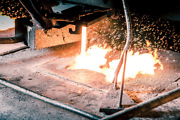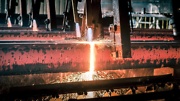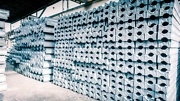
How our steel is produced: The Casting Shop.
The transfer to the continuous casting machine.
At this point the molten steel is transferred to the continuous casting machine. Our casting shop houses the continuous casting machine as well as the break out and lining equipment for the refractory lining, the ladles and the tundishes. The transport crane with a capacity of 190 t takes the ladle with 120 t of molten steel off the transfer carriage and places it onto the ladle turret. The quick changeover of the ladles ensures our continuous casting process. Before opening the ladle the ladle shroud has to be fixed which protects the molten steel against combustion losses caused by the ambient air. While the ladle turret rotates the shroud is blown out and the ladle is changed. Once the final position has been reached the ladle shroud is fixed again on the full ladle. We empty the ladle and then we pour the remaining slag and clean the ladle to prepare it for the next application.
Steel forming with continuous casting.
Precisely dimensioned, refractory nozzles deliver a defined quantity of steel from the tundish into the casting moulds for the liquid steel. These are specially produced copper moulds with the dimensions of the required beam blank. We cool them intensively with water from outside to remove heat from the steel. Inside the mould a strand is built which is guided downwards via a system of rollers through a cooling chamber. By adding casting flux or casting oil we ensure the uniform development of the outer casting shell. Simultaneously we avoid sticking of liquid steel on the mould wall. The fluid level in the moulds is monitored by sensors. The measurements for the individual strands are directly displayed on screens in the control station. Here all important data necessary for our efficient process management are collected and merged. Most importantly here is the control of the casting speed which is dependent on the filling level of the moulds.
Beam blanks cut to measure for use in the rolling mill.
Now the strands solidified in the cooling chamber pass through the pinch roll guides straightening each strand from its radius of 8 m. Next the straightened strands travel to the cutting equipment. At this point automatic flame cutting machines cut the strand to the length specified by the rolling mill using an exact rectangular cutting technique. The cutting process is monitored by a computer system. The cross transportation manipulator transports the beam blanks via roller tables for the hot charging of approx. 600°C directly to our rolling mill. Alternatively the beam blanks are stored in our storage facility until they are required in the rolling mill.
The capacity of our modern continuous casting machine is approx. 150 t of blooms per hour. Our blooms have an unusual form and are called “beam blanks”. We produce various beam blank formats. By using the beam blanks we were able to reduce our deformation work in the rolling mill and to minimize the number of passes on the rolling stands.




 Informationbooklet
Informationbooklet

